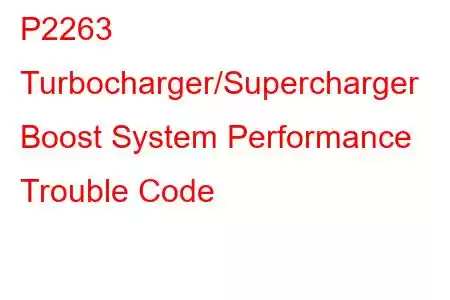P2263 Turbo/Supercharger Boost System Performance
OBD-II Trouble Code Technical Description
Turbocharger/Supercharger Boost System Performance
What does that mean?
This is a generic diagnostic powertrain trouble code, which means it covers all makes/models, 1996-newer. However, specific troubleshooting steps will vary depending on the vehicle.
This code refers to a problem with either the fuel delivery system or a malfunctioning turbocharger boost system. Both systems have a direct effect on the performance of the each other.
Fault code P2263 is set when the difference in exhaust pressure (be it less or greater than the predetermined threshold) is recognized by the Powertrain Control module (PCM).
The OBD trouble code P2263 is generic in nature and encompasses all vehicles so equipped. This is not to say that all vehicles exhibiting this code will have the same diagnostic and repair procedure.
This code is common to gasoline and diesel engines alike. Diagnosis on a diesel is more complicated inasmuch as there are more possible components leading to the failure. Normal gas engines tend to lean strictly toward the turbocharger and its components.
Check the technical service bulletins on your particular model. Ongoing problems of this nature will be addressed in these bulletins along with the manufacturer's recommended repair procedure.
Do to the number of possibilities and degree of complexity, a scanner and service manual are needed for proper diagnosis on a diesel.
To aid your mindset when diagnosing a diesel engine-keep in mind that diesels are 'dirty' in that they produce a great deal of 'soot' which clogs passages in the exhaust flow. Their fuel injection system operates at extremely high pressure which has the potential to create its own problems.
A diesel has two oil pumps, a low-pressure for the internal components, and a high-pressure(3700 PSI) to pressurize the fuel injectors. The fuel pressure itself runs in the neighborhood of 26,000 PSI to overcome the compression pressures.
Symptoms
Symptoms of a P2263 engine code may include:
Gasoline engines:
The engine will feel sluggish and lack acceleration The boost pressure will drop lower than normal Unusual noises may be heard from under the hoodDiesel engines:
White or black smoke may be seen from the exhaust Lack of power and RPM will not reach the higher limits The engine may not start The engine may surge at an idle, which could be dangerousPotential Causes
Experience dictates that an inspection of the turbocharger will turn up the problem the majority of the time. Turbochargers have had many upgrades, such as ceramic bearings and improved materials to increase their longevity, however they are still the most problematic of engine components.
The combination of high temperatures and ridiculously high RPM are a recipe for a shorter life span the most engine components.
Over the years I have found that broken hoses or loose hose clamps causing major boost leaks cause this code to set.
The turbocharger may have failed The boost pressure sensor may have failed Wastegate failure Plugged catalytic converter Faulty Injection Pressure Control (IPC) Faulty Exhaust Back Pressure SensorRepair Procedures
Inspect all hoses for cracks or loose clamps. Inspect the oil supply line to the turbo. Look for any leaks that could slow the oil flow to the bearing. Inspect the wastegate for proper movement. Make sure it closes all the way by detaching the control arm and manually moving it from open to closed. Remove the turbo and inspect the bearing seal for leaks. Oil inside the turbo on either side indicates a bearing failure. Spin the turbo by hand. It should spin easily. Check the exhaust side of the turbo for coking which prevents the vanes from functioning properly. In some cases the turbo can be cleaned. AtRead: 21


